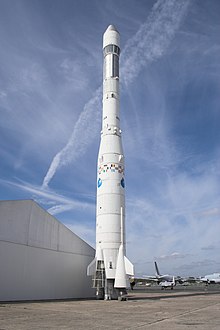
Back Ариана 1 Bulgarian Ariane 1 Catalan Ariane 1 Czech Ariane 1 German Ariane 1 Esperanto Ariane 1 Spanish Ariane 1 Finnish Ariane 1 French Ariane 1 Galician אריאן 1 HE
This rocket article contains payload capacity, but does not include orbital altitude or inclination, which greatly affects the capacity. |
 Ariane 1 mock-up (Photo taken at Musée de l'Air et de l'Espace, Le Bourget, France) | |
| Function | Medium lift launch vehicle |
|---|---|
| Manufacturer | Aérospatiale |
| Country of origin | European Space Agency |
| Size | |
| Height | 50 m (160 ft) |
| Diameter | 3.8 m (12 ft) |
| Mass | 207,200 kg (456,800 lb) |
| Stages | 3 |
| Capacity | |
| Payload to LEO | |
| Mass | 4,850 kilograms (10,690 lb) |
| Payload to GTO | |
| Mass | 1,850 kilograms (4,080 lb) |
| Launch history | |
| Status | Retired |
| Launch sites | ELA-1, Guiana Space Centre |
| Total launches | 11 |
| Success(es) | 9 |
| Failure(s) | 2 |
| First flight | 24 December 1979 |
| Last flight | 22 February 1986 |
| Type of passengers/cargo | Giotto |
| First stage | |
| Powered by | 4 Viking-5 |
| Maximum thrust | 2,771.940 kN (623,157 lbf) |
| Specific impulse | 281 s (2.76 km/s) |
| Burn time | 145 seconds |
| Propellant | N2O4 / UDMH |
| Second stage | |
| Powered by | 1 Viking-4 |
| Maximum thrust | 720.965 kN (162,079 lbf) |
| Specific impulse | 296 s (2.90 km/s) |
| Burn time | 132 seconds |
| Propellant | N2O4 / UDMH |
| Third stage | |
| Powered by | 1 HM7-A |
| Maximum thrust | 61.674 kN (13,865 lbf) |
| Specific impulse | 443 s (4.34 km/s) |
| Burn time | 563 seconds |
| Propellant | LH2 / LOX |
| Part of a series on |
| Private spaceflight |
|---|
| Active companies |
| Active vehicles |
| Contracts and programs |
| Related |
Ariane 1 was the first rocket in the Ariane family of expendable launch systems. It was developed and operated by the European Space Agency (ESA), which had been formed in 1973, the same year that development of the launcher had commenced.
Ariane 1 was the first launcher to be developed with the primary purpose of sending commercial satellites into geosynchronous orbit. Crucially, it was designed with the ability of sending a pair of satellites into orbit on a single launcher, thus reducing costs. As the size of satellites grew, Ariane 1 quickly gave way to the more powerful Ariane 2 and Ariane 3 launchers, which were heavily based upon the original rocket.[1] The Ariane 4 was the last rocket to heavily draw upon the Ariane 1, as the successor rocket Ariane 5 uses a far greater proportion of all-new elements.
- ^ "Ariane 1,2,3". Ariane 1. ESA. 2004-05-04. Archived from the original on 2012-09-06. Retrieved 2009-09-28.
© MMXXIII Rich X Search. We shall prevail. All rights reserved. Rich X Search